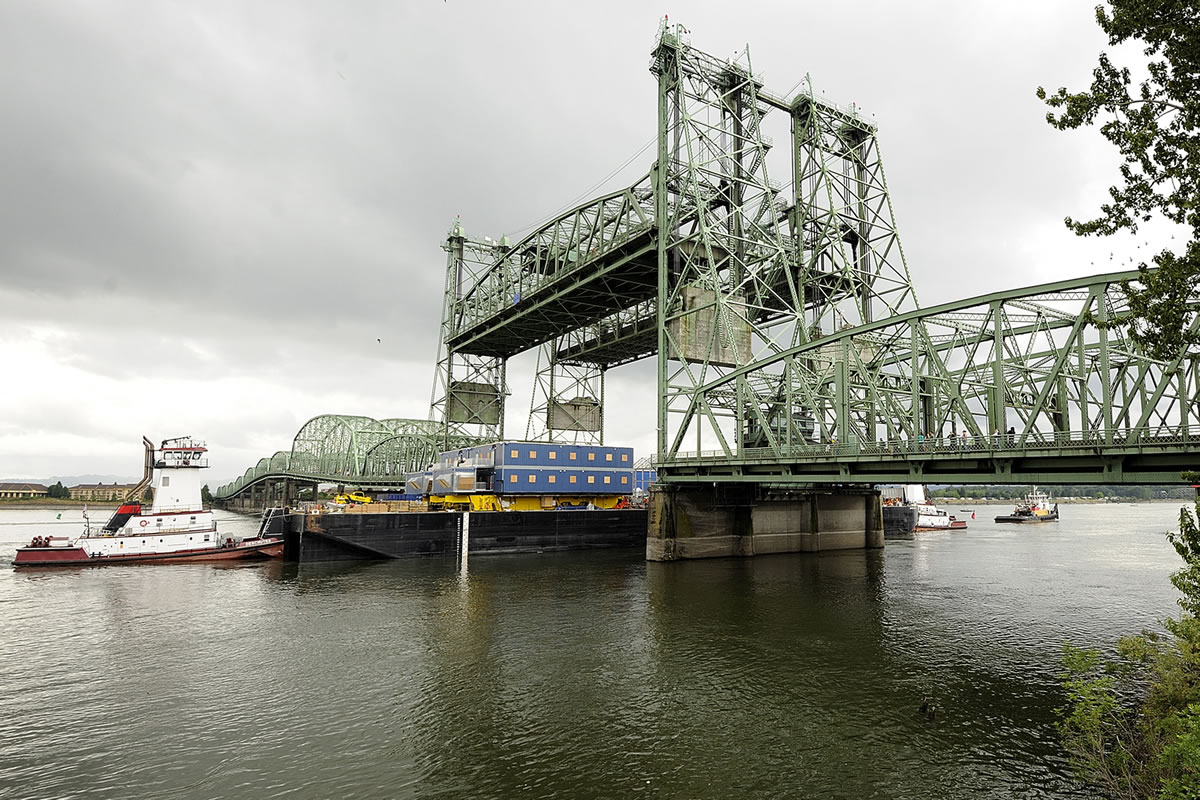The Columbia River Crossing’s proposed 116-foot bridge height could cost three major river manufacturers up to $116 million in lost profits, project officials told the U.S. Coast Guard in a crucial bridge permit application filed last month.
Thompson Metal Fab, Oregon Iron Works and Greenberry Industrial all stand to take a financial hit if the proposed Interstate 5 Bridge replacement is built with 116 feet of headroom, as planned. The existing span connecting Vancouver and Portland offers as much as 178 feet of clearance when lifted.
To mitigate that impact, the CRC expects to pay all three manufacturers for lost earnings, according to other documents supplied to the Coast Guard. The application cites ongoing discussions and “confidentiality agreements” with all three businesses. Proprietary information on the companies is redacted.
It would be up to the manufacturers themselves to decide what to do with any compensation, according to the CRC. But the project offered at least one suggestion. A study filed with the application lists more than a dozen other possible sites where the businesses could relocate at least part of their operations downstream of the new bridge. Most of those sites — as far away as Tacoma or Bellingham — would push them out of the Vancouver-Portland area.
Thompson Metal Fab, for one, would consider moving if it receives enough compensation to make it work, said spokesman Tom Hunt. If it doesn’t, there’s a lot at stake for the local economy, he said.
“You’re talking about a lot of people and a large payroll that leave the community if we’re unable to be properly mitigated,” Hunt said.
Greenberry Industrial is also evaluating possible downstream sites, according to permit documents. Oregon Iron Works, however, is “not interested” in moving.
Thompson, Greenberry and Oregon Iron Works all build and ship large equipment from facilities at the Columbia Business Center, next to Marine Park on the Washington side of the river. They account for more than 1,300 combined jobs across all locations of all three companies. Between 2002 and 2012, a total of 854 jobs were tied to manufacturing projects that would be constrained by a 116-foot-high bridge, according to the CRC. That’s an average of 78 full-time equivalent positions per year.
In its application, the CRC estimates that the three fabricators could lose between $30 million and $116 million in profits. Mitigation costs to the CRC, though still uncertain, would be based on those numbers, said CRC spokeswoman Mandy Putney. And whatever the extra cost ends up being, Washington and Oregon taxpayers would foot the bill.
That lost revenue range is based on current and expected contracts the companies have lined up, Putney said.
But Hunt questioned the projections, saying Thompson feels they’re too low. One bargeload can represent a huge value for a manufacturer, he said, even if those types of shipments only account for one or two bridge lifts per year.
Though it has worries, Hunt noted Thompson Metal Fab’s support of the CRC. The company believes the project is what the region needs, he said — for now.
“If it’s going to put us out of business, obviously we would have to rethink that position,” Hunt said.
Despite possible impacts, the CRC says in the application that more than 99 percent of all river traffic would be unaffected by a 116-foot-high bridge. And the height-constrained manufacturing projects sent down the river in the last decade would have represented only 0.6 percent of the $2.9 billion generated by Columbia River marine activity, according to the CRC. That includes metal fabricators, marine cargo terminals, boat- and shipyards, and recreational activity, the application said.
The application went on to describe other economic benefits from reduced congestion and travel times along a major commercial corridor.
The bridge permit application, filed Jan. 30, was released late Tuesday in response to a public records request by The Columbian and other media. The project’s bridge height has become a key issue because planners initially designed a 95-foot-high span rejected as too low for the river’s economic and navigation needs. Rebuffed by the Coast Guard and others, officials scrambled to come up with a new design at 116 feet late last year.
The Coast Guard must approve the bridge permit for the project to move forward. The agency is in the process of doing its initial review, said Capt. Michael Gardiner of the Coast Guard’s 13th District in Seattle. The Coast Guard aims to make a decision on the application by Sept. 30, he said.
Reviewers aren’t looking for any specific threshold for impacts or mitigation, Gardiner said. There may be multiple paths that lead to the ultimate destination — in this case, a project that meets the “reasonable needs” of river navigation, he said.
Whether the CRC’s current plan passes muster remains to be seen.
In addition to replacing the I-5 Bridge, the $3.4 billion CRC would rebuild freeway interchanges on both sides of the Columbia River and extend light rail into Vancouver.
Both the Washington and Oregon legislatures are considering funding plans that would provide state funding to the CRC. Project leaders are hoping to begin construction in late 2014.
Eric Florip: 360-735-4541; http://twitter.com/col_enviro; eric.florip@columbian.com.




